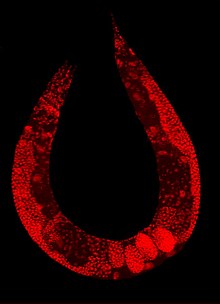
Back Vielzeller ALS متعددة الخلايا Arabic বহুকোষী জীৱ Assamese Многоклетъчно Bulgarian বহুকোষী জীব Bengali/Bangla Bevedeg lieskellig Breton Organisme pluricel·lular Catalan Daghang-selyulang organismo CEB Mnohobuněčnost Czech Organeb amlgellog Welsh

A multicellular organism is an organism that consists of more than one cell, unlike unicellular organisms.[1] All species of animals, land plants and most fungi are multicellular, as are many algae, whereas a few organisms are partially uni- and partially multicellular, like slime molds and social amoebae such as the genus Dictyostelium.[2][3]
Multicellular organisms arise in various ways, for example by cell division or by aggregation of many single cells.[4][3] Colonial organisms are the result of many identical individuals joining together to form a colony. However, it can often be hard to separate colonial protists from true multicellular organisms, because the two concepts are not distinct; colonial protists have been dubbed "pluricellular" rather than "multicellular".[5][6] There are also macroscopic organisms that are multinucleate though technically unicellular, such as the Xenophyophorea that can reach 20 cm.
- ^ Becker, Wayne M.; et al. (2008). The world of the cell. Pearson Benjamin Cummings. p. 480. ISBN 978-0-321-55418-5.
- ^ Chimileski, Scott; Kolter, Roberto (2017). Life at the Edge of Sight: A Photographic Exploration of the Microbial World. Harvard University Press. ISBN 978-0-674-97591-0.
- ^ a b Lyons, Nicholas A.; Kolter, Roberto (April 2015). "On the evolution of bacterial multicellularity". Current Opinion in Microbiology. 24: 21–28. doi:10.1016/j.mib.2014.12.007. ISSN 1879-0364. PMC 4380822. PMID 25597443.
- ^ Miller, S.M. (2010). "Volvox, Chlamydomonas, and the evolution of multicellularity". Nature Education. 3 (9): 65.
- ^ Hall, Brian Keith; Hallgrímsson, Benedikt; Strickberger, Monroe W. (2008). Strickberger's evolution: the integration of genes, organisms and populations (4th ed.). Hall/Hallgrímsson. p. 149. ISBN 978-0-7637-0066-9.
- ^ Adl SM, Simpson AG, Farmer MA, Andersen RA, Anderson OR, Barta JR, Bowser SS, Brugerolle G, Fensome RA, Fredericq S, James TY, Karpov S, Kugrens P, Krug J, Lane CE, Lewis LA, Lodge J, Lynn DH, Mann DG, McCourt RM, Mendoza L, Moestrup O, Mozley-Standridge SE, Nerad TA, Shearer CA, Smirnov AV, Spiegel FW, Taylor MF (October 2005). "The New Higher Level Classification of Eukaryotes with Emphasis on the Taxonomy of Protists". J. Eukaryot. Microbiol. 52 (5): 399–451. doi:10.1111/j.1550-7408.2005.00053.x. PMID 16248873. S2CID 8060916.